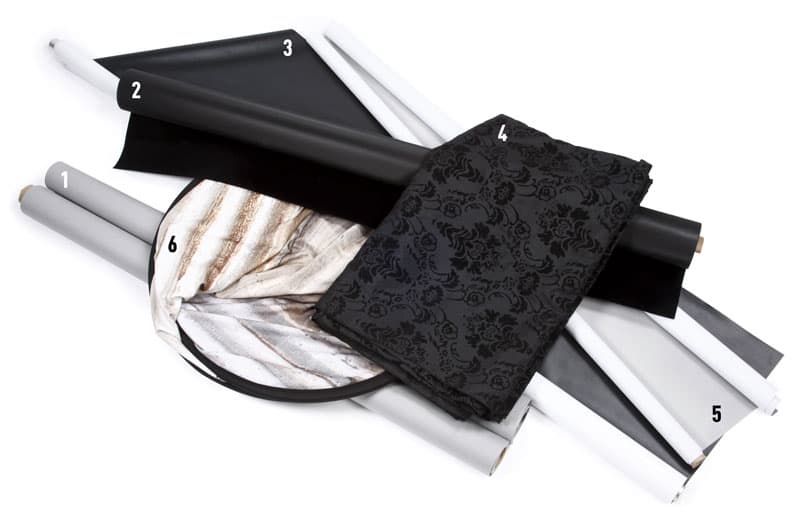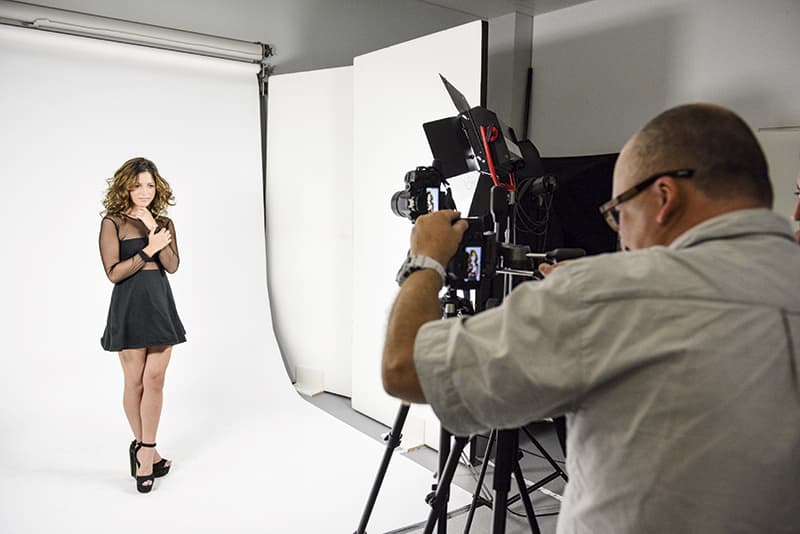If you’d like to own and run a photography studio, you’ll need to equip yourself properly. Have a look at our studio photography kit list list of to find out more about some of the things you’ll need during your career as a studio photographer.
Take a look at this basic set-up and bear in mind that when you have your own studio, it’s easy for your kit collection to grow and grow as your work and clients vary.
Studio photography kit list: camera

With studio photography, you don’t need to necessarily worry about the camera being as small and as light as possible, as you won’t be lugging it along on big hikes as you would with landscape photography, or carrying it all day, as you would with wedding photography.
As it’s likely that the type of photos you’ll be taking will be printed very largely, you may want to look for something which has a very high resolution.
Medium format cameras, such as the Fuji GFX 50S are often considered the preferred tool of the studio photographer, while some DSLRs are starting to feature huge resolutions too.
The obvious choice for Canon photographers is a Canon 5DSR which has a 50 million pixel sensor, and has a low pass cancellation filter for precise detail. When it comes to Nikon, the D810 has a 36 million pixel sensor, with no low pass filter at all – so it’s also great for detail.
Studio photography kit list: lenses

What kind of lenses you need for studio work will depend on the subjects you’re photographing.
However, it’s unlikely that you’re going to need either super wide angle lenses, or super telephoto lenses for studio work.
Many studio photographers take product or food shots, for which a macro prime lens is the obvious choice. The other big subject covered by studio photographers is portraits – for which, a macro lens is also good, as are other prime lenses, such as 85mm or 50mm. A tilt-shift lens can also come in incredibly handy for food and product shots as you get fine control over what is and isn’t in focus.
If you’re photographing large groups (such as family portraits), you may need something wider, such as a 28mm lens. However, this will depend on how big your studio is and how far away you can get from the subject.
Studio photography kit list: backdrop

You’ll need at least one backdrop in your studio to place your subject(s) in front of. To begin with, you’ll probably start with a simple white backdrop, but the possibilities for different backdrops are almost limitless.
You could have different coloured backdrops (black and grey are obvious choices, but bright colours also work well for certain situations), or backdrops which appear as if you’re outside – such as graffiti walls, brick walls, metal and so on, to create different looks.
The size of the backdrop will of course depend on the size of your studio, but generally the bigger the better as you’ll have more flexibility to fit your subjects on.
Studio photography kit list: lighting

As you’ll usually be relying entirely on artificial lighting when working in a studio, you’re going to need a variety of lights for your setup. Again, the possibilities for lighting setups are almost endless, and depend on what you’re photographing.
You’ll need at least one main light, and probably at least one other light if you’re photographing portraits. There’s also a range of lighting accessories that you’re going to find indispensable too, including reflectors, lighting stands, and gels.
Investing in some blackout blinds or materials is a good idea if your studio has any windows in. You may want to keep the possibility of opening the blinds if you want to work with window light occasionally, or, you could tape up the windows and seal out the light completely. Even a band of window light can ruin an otherwise perfect lighting setup.
Westcott Apollo Orb 43in Octagonal Light Modifier review
Studio photography kit list: flash and triggers

In addition to lights, you may also want to use flashguns. These can be placed on stands around your studio to create specific lighting effects, or coupled with softboxes, umbrellas and so on for other kind of looks.
You’ll need some remote triggers for your flash units too, as you’ll be working off-camera.
Nissan Air 1 Commander Air R Receiver review
Studio photography kit list: tripod

Unlike most forms of outdoor photography, you don’t need to worry too much about a studio tripod being lightweight and portable since it likely won’t move too far.
You may find that you’re not using a tripod for portrait and family shots, but for other kinds of studio work such as food and still life, they’re essential.
Look for a tripod which has a reversible centre post, which allows you to point the camera directly down and other awkward angles. Also look for a tripod head that has a ball socket for maximum flexibility.
Studio photography kit list: computer and tether set up

Many studio photographers like to shoot tethered, that is, with the camera linked-up to a computer so the image appears on screen immediately. It means you can clearly see the results on a large screen and aren’t relying on the smaller screen of your camera which may not show fine detail so well – or so quickly.
You can tether in a variety of different ways – either via a cable or wirelessly, with every setup dependent on the options your camera allows. If you can tether wirelessly you do away with pesky cables running over your studio floor, so if you can do that, that’s advised.
When it comes to the computer itself, look for one which has a fast processor and also look for the biggest screen you can afford.
Studio photography kit list: batteries, chargers and other accessories

A typical studio setup burns through a lot of electricity, whether that’s the camera itself, the lighting, or other accessories.
Make sure you have spare batteries and spare chargers, and you’ll also probably want to invest in some extension cables so you can have many things plugged in at once.
Extra memory cards are also an obvious choice, with the biggest memory you can afford.







